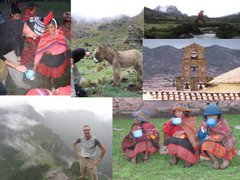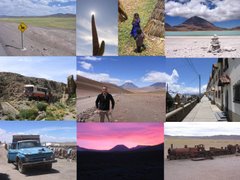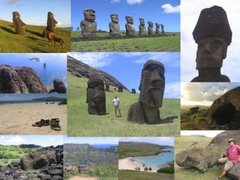 (Postcard shot - I had to get there very early to get this photo without any peeps in it. Very early!)
(Postcard shot - I had to get there very early to get this photo without any peeps in it. Very early!) The Taj Mahal. Everyone's heard of it and everyone knows what it is and what it looks like. It's been called the world's greatest monument to love, and the greatest wonder of the world. And I probably need to say less about this than anything else I’ve seen in the year.
 (The world's greatest monument to love)
(The world's greatest monument to love)
Actually it’s maybe a rather peculiar thing to say, but there’s probably less I can say about the Taj Mahal than any of the other famous sights I’ve seen. A few things hadn't occurred to me before I visited - being a mausoleum, the interior of the Taj Mahal is very basic and uncomplicated; for the same reason, there isn’t any story around who’s lived in the building, and; given that it’s preserved in an almost and unchanged perfect state, there isn’t much to be said about the building post-construction either.
In fact, beyond the exterior of the building, there’s just not much to ‘see’. (Ok yeah, there is a bit of a slant in this pic, but I was at a bit of a slant myself after getting up at 6am.)
(Ok yeah, there is a bit of a slant in this pic, but I was at a bit of a slant myself after getting up at 6am.)
But what an exterior.
The building is perfect. Even a layman like me can sit and study the Taj and see the clever, almost magical, techniques that have been used to make this possibly the greatest sights on earth*. For example, the spires, arches, doorways and windows all point upwards, making the structure look more slender than it really is. The minarets are perfectly positioned to frame the building and also add to that slender effect. (They were also built tilting out slightly so that they would collapse away from the mausoleum in the event of an earthquake.)
* Maurice Malpas lifting the Scottish Cup for Dundee United excepted, of course. So the Taj was a real highlight. Actually, Agra itself was a great place to visit with a few other stunning sights as can be seen from the pictures below and I was happy that by chance I'd given myself three days there as opposed to the day/2-day trip advised by all the guidebooks.
So the Taj was a real highlight. Actually, Agra itself was a great place to visit with a few other stunning sights as can be seen from the pictures below and I was happy that by chance I'd given myself three days there as opposed to the day/2-day trip advised by all the guidebooks.
The longer stay came about after another change of plan. I had thought I might just have a day in Agra and then move on to Jaipur but the difficulties of travelling round India made me knock Jaipur off the schedule. I could already write a few blogs about Indian train travel in particular. Train travel is an essential part of the Indian experience both for locals and visitors. India Rail runs no less than 14,000 trains each day, carrying an amazing 14 million passengers. 
(Right: I've only left Sydney a few weeks and I'm already back on the teapots! Just beer rather than lethal cocktails this time at least. It was nice to meet a couple of Scots - Scott and Louise - in Agra. They are living and working in Osaka (the Japanese Glasgow I'm led to believe) and were in India, like me, for a couple of weeks' holiday.)
(Below left: from the rooftop of my hotel I got a great view of sunset over the Taj Mahal. And I also got a great view of local kids (and 'older kids') preparing for India's national kite-flying day.)
The journey from Amritsar to Agra was a 14 hour overnight trip. On such a long trip, it’s important to be offered more than a Scotrail cup of tea and sandwich. After just 10 minutes, four staff members had already passed by my berth offering, variously… tea, dinner, cold drinks and tomato soup. This was followed 10 minutes later by the man with the sweeties tray. Just like being at the cinema when I was a kid.
Plus, I had a bunk, which, though a little short for my 6 foot and 2 inches, was still long enough to allow some sleep. And the air conditioning was perfect.
This was all marvelous and a million miles from the soul-crushing, waking nightmare that is booking your ticket in the first place. The booking process involves a trip to the train station where you undergo a marathon of queueing (by which I mean frantic jostling) with a group of other would-be travellers (by which I mean hundreds of veteran queue-jumpers who all seem to have tenuous personal connections with the person at the front of the queue – you’d be amazed at the number of ‘friends’ I made when I was next in line to be served…) for my travel ticket (by which I mean a piece of paper bearing a vague suggestion that I might be able to board a train after reconfirming at several different and well hidden locations around the station on several different occasions).
of ‘friends’ I made when I was next in line to be served…) for my travel ticket (by which I mean a piece of paper bearing a vague suggestion that I might be able to board a train after reconfirming at several different and well hidden locations around the station on several different occasions).
So the trains are lovely, fabulous, great, but after arriving in Agra I really didn’t want to have to book another train journey.
Train transport isn't the only option for getting round India though. Bus travel is always another option. However, I had avoided Indian buses on the dire advice of a number of travelers who I imagined had collectively spent enough time in India to know what they were talking about.
But after a while such a volume of dire warnings had built up that I felt I must be missing out on something… probably not something pleasant, but perhaps something character building, which is after all what travel in India seems to be about.

So when I decided to make the two hour journey out of Agra to the world heritage site of Fatephur Sikri, I opted to go on the buses.

In fact, the experience wasn’t bad at all. What I will say is that the main problem is without a doubt overcrowding. In fact, overcrowding can be so severe as to be comical.

To put it another w ay, on my particular journey I had an opportunity to get to know several local people intimately. In fact, after the bus had taken on its full complement of passengers, I was convinced that everyone on the bus must be physically connected through bodily contact. I know that at any one point in time I was touching at least four other people - and sometimes up to 6 or 7 - with various of my limbs and other body parts.
ay, on my particular journey I had an opportunity to get to know several local people intimately. In fact, after the bus had taken on its full complement of passengers, I was convinced that everyone on the bus must be physically connected through bodily contact. I know that at any one point in time I was touching at least four other people - and sometimes up to 6 or 7 - with various of my limbs and other body parts.
With little chance of reading or even breathing in a relaxed or peaceful manner, I got to wondering whether a skillful and vigorous shunt of a knee could have induced the driver to steer left or right as desired, through a sort of chain reaction of involuntary body movements rippling from the back to the front of the bus.
The shots above and below are from Fatephur Sikri, a fort built by the Mughal emperor in the mid-16th century, about a hundred years before the Taj Mahal. I was just knocked-over by how much this temple reminded me of those famous drawings by M C Escher. In fact, I'd swear he must have seen these sights, or been influenced by them in some way.

All the pictures from this fort were helped hugely by the wonderful 'little fluffy clouds'-type sky on the day. The next picture makes me think of a famous picture by Magritte that hangs in the Moma in New York.

Ok, enough Tony Hart style exposition. I've now been back to India Rail's booking office and, with scratches on my back and a slightly deranged and sweaty look, I'm heading back to Delhi.









No comments:
Post a Comment